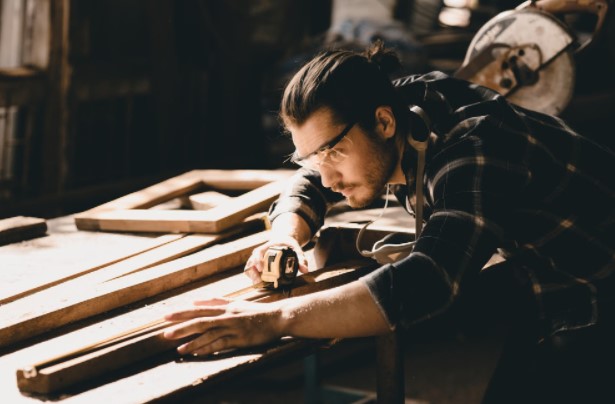Sell with Us
Living & Dining
Bedroom
Lighting
Kitchen
Bath & Laundry
Outdoors
Decorating & Flooring
Building
Woodworking 101: A Newcomer’s Guide to Working With Timber
Being creative has proven benefits to mind, wellbeing and spirit. There’s something special about creating something out of nothing. A creative hobby can make the hours fly by and are a brilliant way of spending your leisure time.
 Some people like to draw, sketch, paint or doodle. Others prefer to knit, sew, crochet or embroider. Others still prefer to use technology to create, such as graphic design or other computer-assisted art.
One creative outlet that you may have considered is woodworking. Using electric saws and other tools, a woodworker can create a myriad of extraordinary objects from timber. And as well as being a good outlet, the things a woodworker makes are incredibly useful. From bed bases to door frames, you can make a lot of things out of wood.
In this helpful article, we’ll share the woodworking 101 primer: a newcomer’s guide to working with timber.
Some people like to draw, sketch, paint or doodle. Others prefer to knit, sew, crochet or embroider. Others still prefer to use technology to create, such as graphic design or other computer-assisted art.
One creative outlet that you may have considered is woodworking. Using electric saws and other tools, a woodworker can create a myriad of extraordinary objects from timber. And as well as being a good outlet, the things a woodworker makes are incredibly useful. From bed bases to door frames, you can make a lot of things out of wood.
In this helpful article, we’ll share the woodworking 101 primer: a newcomer’s guide to working with timber.
 Some people like to draw, sketch, paint or doodle. Others prefer to knit, sew, crochet or embroider. Others still prefer to use technology to create, such as graphic design or other computer-assisted art.
One creative outlet that you may have considered is woodworking. Using electric saws and other tools, a woodworker can create a myriad of extraordinary objects from timber. And as well as being a good outlet, the things a woodworker makes are incredibly useful. From bed bases to door frames, you can make a lot of things out of wood.
In this helpful article, we’ll share the woodworking 101 primer: a newcomer’s guide to working with timber.
Some people like to draw, sketch, paint or doodle. Others prefer to knit, sew, crochet or embroider. Others still prefer to use technology to create, such as graphic design or other computer-assisted art.
One creative outlet that you may have considered is woodworking. Using electric saws and other tools, a woodworker can create a myriad of extraordinary objects from timber. And as well as being a good outlet, the things a woodworker makes are incredibly useful. From bed bases to door frames, you can make a lot of things out of wood.
In this helpful article, we’ll share the woodworking 101 primer: a newcomer’s guide to working with timber.
Get Tooled Up
The first step to working with wood is to have the right tools. Like any craft or hobby that involves making stuff, having the right equipment is the first step in your journey. As a rule of thumb, you’ll want a mix of hand and power tools. You’ll need an electric or battery operated saw, such as a circular saw. You’ll also want a jigsaw for more precise cutting work. In addition to this, you’ll want a planer, which is helpful for shaving millimetres of timber off wood, as this is often needed. Furthermore, you may want a sander to sand back rough timber to make it smooth, as well as smaller tools such as screwdrivers, pliers and the like. Some other tools you may want to acquire include chisels, scrapers, and hand saws. You’ll also want some clamps, which are useful for holder pieces of timber together while adhesives set.Choose Your Timber
When it comes to beginner woodworkers, you should start with cheaper timber, such as common pine or whitewood. The reason for this is because it is affordable, and if you make a mistake (which you probably will, and that’s ok), you haven’t wasted a lot of money on the wood. As you improve your woodworking skills, you can work up to more expensive and higher quality timber.Acquire a Workbench
Working with wood without a workbench is a bit like cooking without a kitchen bench. A workbench is a place where you can rest wood while you cut it, and hold pieces together to glue them, and a variety of other functions that will support your new creative endeavour. You can find a decent workbench at most hardware stores, but it’s also worth checking out the secondhand markets and having a look online on places like Gumtree and Facebook Marketplace; you may find a bargain.Pick an Easy Project to Begin With
For your first woodworking project, pick something easy to build. Like any creative project, you shouldn’t attempt more complicated builds until you’re confident and have made the mistake that helped you learn. Once you’ve finished a few more straightforward projects, begin to scale up the difficulty. Make sure to research your projects online, watch tutorials and otherwise build your knowledge.Some examples of an easy project to start with include:
- A food chopping board
- A shoe rack
- A bench
- A small table
